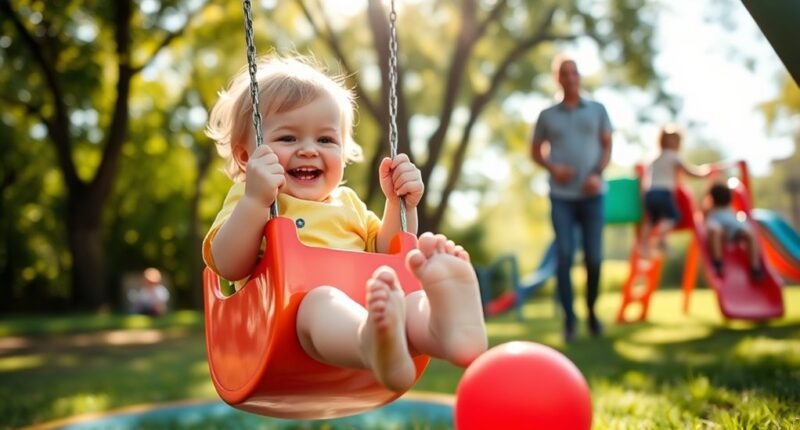From ages 2 to 5, your toddler hits key physical milestones that shape their growth. At 2, they master walking, running, and climbing. By 3, they improve balance, ride tricycles, and enjoy active play. At 4, they hop, skip, and refine fine motor skills like drawing and using scissors. These milestones are vital for their physical and social development. Keep exploring to discover more about how to support their growing skills and confidence.
Key Takeaways
- Toddlers aged 2 to 3 master walking, running, jumping, and climbing, showcasing significant physical growth and fine motor skill development.
- By age 3 to 4, children improve their coordination, riding tricycles, alternating feet on stairs, and engaging in active play.
- At 4 to 5 years, toddlers refine skills like hopping, using scissors, and developing storytelling abilities, indicating cognitive and social growth.
- Active play enhances gross motor skills, promoting strength, balance, coordination, and social interaction among toddlers.
- Individual variations in growth can be influenced by genetics, environment, and cultural practices, impacting developmental milestones.
Key Milestones for 2 to 3 Year Olds
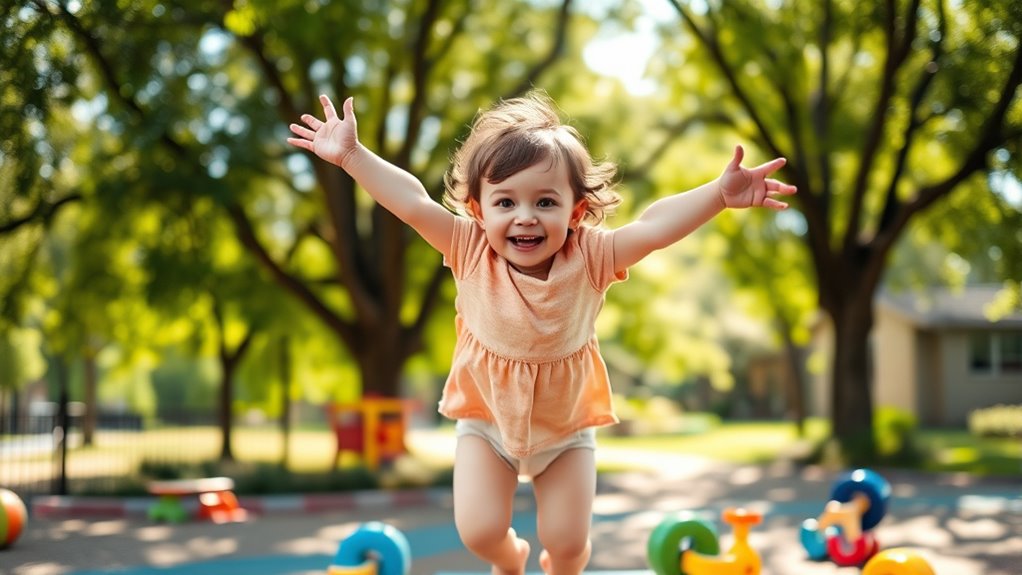
During the exciting ages of 2 to 3 years, toddlers experience significant physical growth and development.
You’ll notice them mastering walking and quickly progressing to running, jumping, and climbing with newfound ease. They begin maneuvering stairs, often using one foot per step. Engaging with educational toys can further enhance their physical skills and coordination, while creating a safe living environment can also play a crucial role in their development. As their fine motor skills develop, they can hold crayons and start dressing themselves, though they’ll still need your help. Understanding the importance of safe sleep environments can also aid in their overall well-being and recovery from daytime activities, as children with emotional instability may require additional support during this active stage.
You might see them kicking and throwing balls with both hands and balancing on one foot for a few seconds. Climbing structures becomes a favorite activity, as they jump from low steps and navigate obstacles with increasing agility. Their confidence grows, allowing for smoother running and attempts at more complex movements, making this a joyful and thrilling time for both of you. Additionally, ensuring a safe sleep environment can support their overall development and well-being during this active stage.
Advancements in 3 to 4 Year Olds
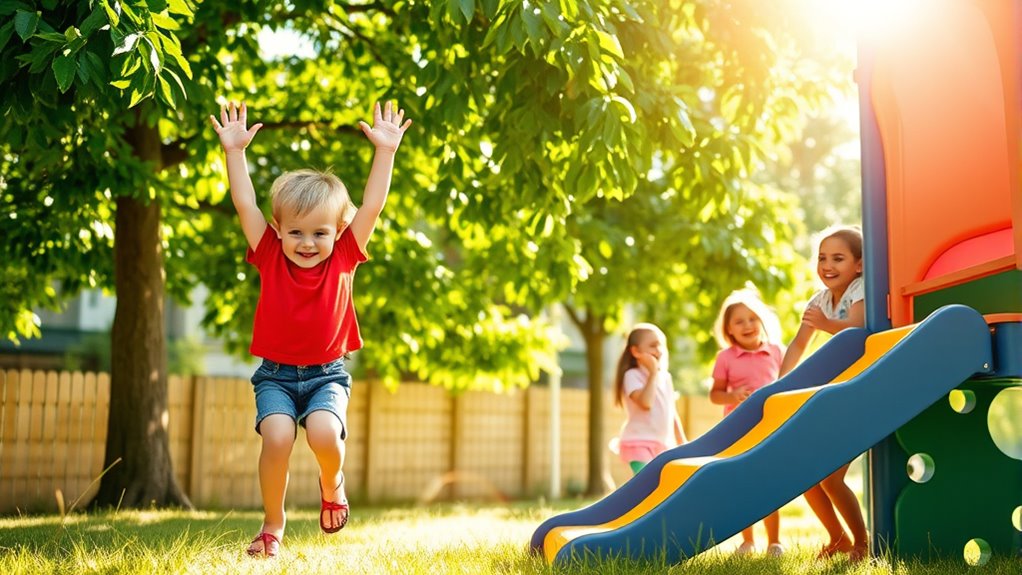
As toddlers progress into the ages of 3 to 4, you’ll notice even more remarkable advancements in their physical and cognitive abilities. They can now walk up and down stairs, alternating feet, and run confidently while riding a tricycle. Kicking, throwing, and catching a ball become common skills, along with climbing on furniture. Additionally, safety during playtime is essential to prevent injuries as they explore their environment. The importance of sustainable fashion can also be highlighted, as children’s clothing increasingly incorporates eco-friendly materials. Engaging in physical activities helps promote critical periods for developing essential motor skills. Regular physical activity can also support overall hormonal balance as they grow.
You’ll see them hop and stand on one foot for up to five seconds, showcasing improved balance and coordination.
In fine motor skills, they use age-appropriate scissors, copy squares and circles, and even begin drawing simple people. Building towers with four or more blocks becomes achievable.
Emotionally, they’ll engage in imaginative play, cooperate with peers, and express a range of feelings, marking significant growth in their social development. Additionally, early socialization plays a crucial role in their development, similar to how it benefits puppies in becoming well-adjusted adults.
Skills Development in 4 to 5 Year Olds
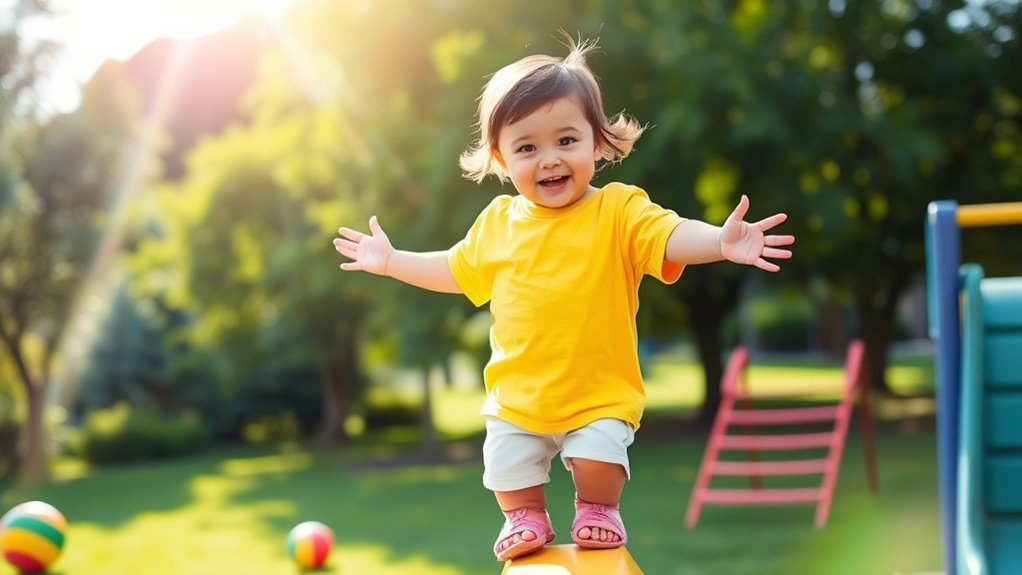
At the age of 4 to 5, children start to refine their skills across various domains, showcasing impressive physical, cognitive, social, and language developments.
At ages 4 to 5, children refine their skills, demonstrating remarkable growth in physical, cognitive, social, and language areas.
They can hop on one foot, climb stairs with alternating feet, and stand on one foot for a few seconds. Their balance improves, and they become more coordinated in throwing and catching balls. Fine motor skills flourish as they cut with child-safe scissors, draw simple shapes, and print some letters. Engaging with educational toys during this stage can further enhance their fine motor development and coordination. Incorporating playful communication through games can also encourage creativity and social interaction among peers. Additionally, participating in group activities helps improve their teamwork skills and boosts confidence. During this period, consistent self-care practices can also support their overall emotional and physical well-being.
Cognitively, they tell longer stories, count objects, and recognize colors. Socially, they build friendships, cooperate with peers, and express emotions.
Language skills advance with longer sentences, a growing vocabulary, and improved conversational abilities, marking significant progress in their overall development. Additionally, emotional regulation becomes essential during this stage as children learn to manage their feelings and interactions with others.
Understanding Gross Motor Skills Progression
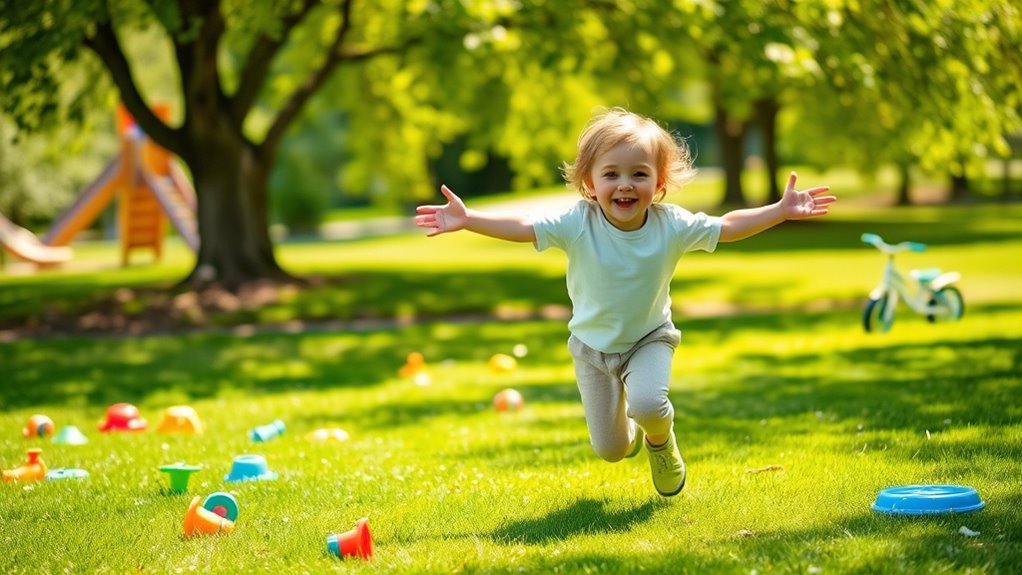
Understanding gross motor skills progression is essential for recognizing how your toddler develops physical abilities that lay the foundation for future activities. These skills involve large muscles for actions like walking, running, and jumping.
As your child grows, they’ll shift from rolling to crawling and eventually to walking. At age two, toddlers can walk steadily, start running, and climb stairs with assistance. Incorporating outdoor adventures into their routine can further enhance their physical development. Engaging in regular exercise requirements tailored to their age and abilities can significantly boost their coordination and strength. Additionally, trust issues may arise if caregivers are inconsistent in providing support, impacting the child’s confidence in their physical abilities. Encouraging gentle methods that support emotional needs can also foster a trusting environment for physical exploration.
By three, they gain better control over their movements, mastering tasks like balancing on one foot and catching large balls. By four to five years, your child can skip, ride a bicycle, and even perform somersaults.
Each child progresses differently, but tracking these milestones helps you support their growth effectively. Additionally, fostering a digital-friendly environment can enhance their engagement in physical activities and creative play.
The Role of Active Play in Development
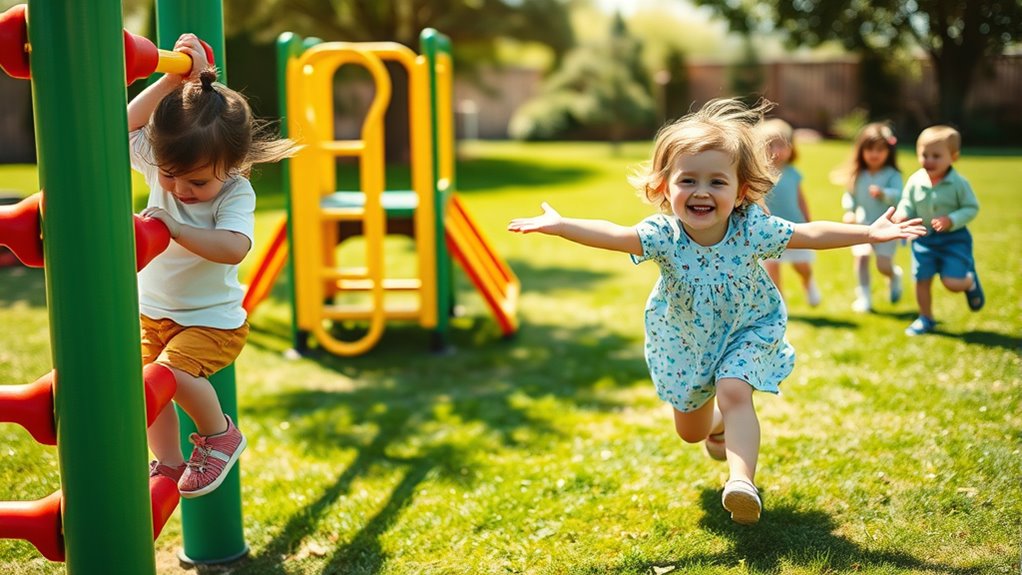
Active play plays an essential role in your toddler’s overall development, building on the gross motor skills they’ve started to master. Engaging in activities like running, jumping, and climbing promotes strength, balance, and coordination. Regular outings to parks or playgroups can also enhance physical development through varied experiences.
These experiences enhance both gross and fine motor skills, vital for daily tasks. Regular active play not only supports physical literacy but also fosters a lifelong love of activity, forming healthy habits that extend into adulthood.
Moreover, active play encourages social interaction, helping your child develop sharing, cooperation, and problem-solving skills. It boosts cognitive development, enhancing focus and creativity. Additionally, incorporating Montessori toys into playtime can further enhance hands-on learning and exploration.
Individual Variations in Toddler Development
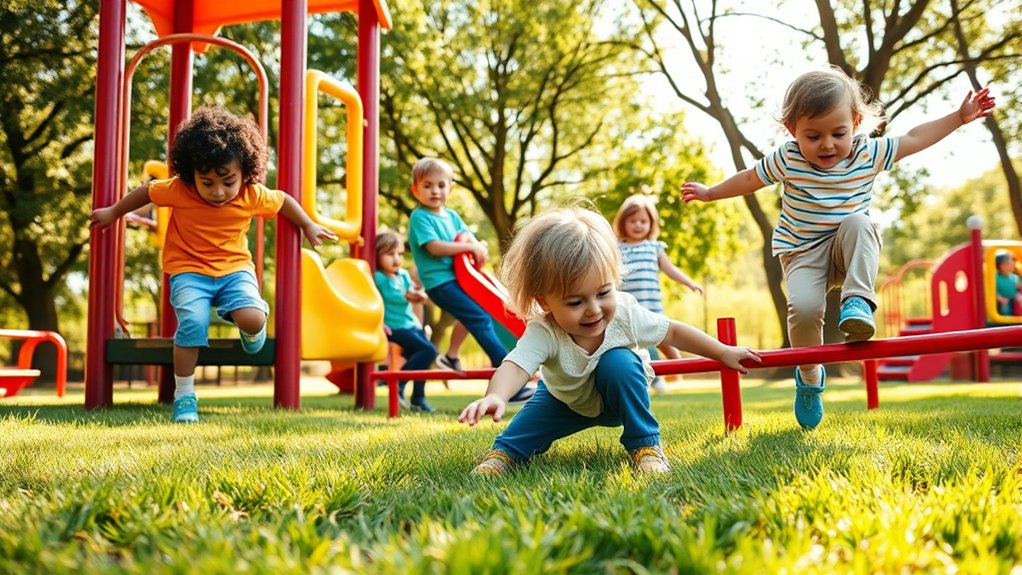
While every toddler develops at their own pace, individual variations in their growth can be influenced by a variety of factors. Genetic inheritance plays a vital role in physical development, while environmental influences, such as access to resources and family lifestyle, can either accelerate or delay milestones.
Premature birth often leads to developmental delays, affecting motor skills and social interactions. A child’s temperament can also shape their engagement with the world around them. Additionally, adequate nutrition is essential for peak growth.
Cultural practices and socioeconomic factors further impact developmental opportunities, with family dynamics and healthcare access playing significant roles. Recognizing these variations helps caregivers and educators provide tailored support for each child’s unique developmental journey.
Frequently Asked Questions
How Can I Encourage My Toddler to Be More Active?
To encourage your toddler to be more active, create a safe play environment where they can explore freely.
Incorporate outdoor activities like trips to the park or backyard games.
Introduce interactive games, such as tag or hide and seek, to make movement fun.
Include structured activities like dancing or obstacle courses for variety, while also allowing time for unstructured play.
Finally, limit screen time to promote more active play.
When Should I Be Concerned About My Child’s Physical Development?
You should be concerned about your child’s physical development if they miss key milestones, like standing unassisted by 12 months or walking independently by 14 months.
If you notice limited improvement in their gross motor skills or persistent challenges with balance, it’s important to consult a pediatrician.
Regular check-ups can help track their progress, and early intervention can make a significant difference, so don’t hesitate to seek professional advice if you’re worried.
What Activities Promote Fine Motor Skills for Toddlers?
Did you know that toddlers can master over 50 fine motor skills by age three?
To promote these skills, try activities like the Card Slot Drop, where your child drops cards into a container, or the Tape Rescue, peeling tape to retrieve toys.
Engaging in playdough manipulation boosts finger strength, while sorting pom-poms enhances coordination.
Simple tasks like peeling fruits or squeezing a baster during bath time can also make a big difference!
How Do I Create a Safe Play Environment for My Child?
To create a safe play environment for your child, start by removing sharp edges and securing unstable furniture.
Use childproof items and regularly inspect toys for hazards.
Set up defined play areas with soft surfaces to cushion falls and supervise playtime closely.
Foster emotional safety by establishing clear rules and encouraging open communication.
Guarantee outdoor spaces have age-appropriate equipment and protective surfacing, while dressing your child appropriately for the weather.
What Role Do Nutrition and Sleep Play in Physical Development?
Nutrition and sleep greatly shape your child’s physical development. Nourishing meals packed with protein, vitamins, and variety fuel growth and energy while supporting strong muscles and bones.
Sleep, on the other hand, secures sound growth hormone secretion, strengthens immunity, and sharpens cognitive skills.
When you prioritize a balanced diet and consistent sleep schedule, you’re setting the stage for successful development.
Together, these factors foster flourishing futures for your little one.
Conclusion
As your toddler grows, they leap into new adventures, climb toward independence, and run toward discovery. Each milestone marks a vibrant step in their journey, from mastering simple movements to embracing more complex skills. Celebrate their progress through active play, nurturing their physical growth and igniting their imagination. Remember, every child develops at their own pace, so cherish the unique path your little one takes, filled with joy, laughter, and boundless energy. Together, you’re building a bright future.
